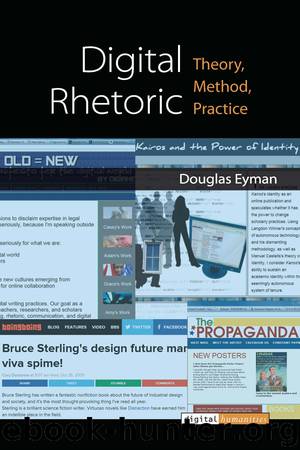Digital Rhetoric: Theory, Method, Practice by Douglas Eyman

Author:Douglas Eyman
Language: eng
Format: epub
Publisher: The University of Michigan Press
Published: 2018-05-15T00:00:00+00:00
Nodes and Links
Initial approaches to the concept of network used it primarily as a metaphor—borrowing the language of networking from graph theory, translating vertices and edges into nodes and links and connecting the idea of a network node Page 81 → to Barthes’s (1974) term “lexia” (which he defines as “a unit of reading” [6]) in order to theorize hypertext (and, in particular, hypertext fiction) as constructed network.
Both “node” and “link” become important to digital rhetoric as they represent two rhetorical forms that are available for analysis, but it is the network itself that has become the more powerful form in terms of its affordances and constraints and the ways in which it mediates rhetorical situations, facilitates rhetorical ecologies, and impacts the formation of digital identity. In rhetorical terms, networks exercise power, and as Ulises Mejias (2008) argues, “networks—as assemblages of people, technology and social norms—arrange subjects into structures and define the parameters for their interaction, thus actively shaping their social realities” (qtd. in Langlois et al., 2009, 429). While the application of network theory has a long history in the social sciences (particularly in terms of social network analysis, covered in more detail in chapter 3), its use in humanities disciplines is relatively new. In 2004, a special issue of JAC focusing on complexity theory (which draws on network theories and methods) featured a number of articles that applied network theory to rhetorical theories and methods. Editors David Blakesley and Thomas Rickert (2004) asked authors to respond to Mark C. Taylor’s (2003) The Moment of Complexity: Emerging Network Culture, suggesting that “Taylor’s claims concerning our emergent network culture and its complex, adaptive logics challenge current postmodern and cultural theories while opening new fault-lines in the established narratives of the humanities in general” (824). Byron Hawk’s (2004) contribution to the issue begins by arguing, “The ancient civic space that led to the emergence of rhetoric has been replaced by contemporary network space” but that there are “few rhetorical theories that adequately address the complexities of this new social space” (831–32). Hawk suggests that a project to build a rhetorical theory based on the topoi of complexity and networks could begin by mapping the rhetorical terms of classical rhetoric to the vocabulary of complexity and network theory (which he proceeds to do, relating heuristics to schemata, the rhetorical situation to complex adaptive systems and reframing logos, ethos, and pathos as network, screen, and affect, respectively).
Tiziana Terranova’s Network Culture (2004) presents a detailed overview of the network as rhetorical construct, which she frames as a network culture that is “inseparable both from a kind of network physics (that is physical processes of differentiation and convergence, emergence and capture, openness and closure, and coding and overcoding) and a network politics (implying the existence of an active engagement with the dynamics of information flows)” (3). A crucial move that Terranova makes draws on the larger understanding of networks as systems (not just technological but also biological and social) Page 82 → that can enact
Download
This site does not store any files on its server. We only index and link to content provided by other sites. Please contact the content providers to delete copyright contents if any and email us, we'll remove relevant links or contents immediately.
Cecilia; Or, Memoirs of an Heiress — Volume 1 by Fanny Burney(32503)
Cecilia; Or, Memoirs of an Heiress — Volume 2 by Fanny Burney(31913)
Cecilia; Or, Memoirs of an Heiress — Volume 3 by Fanny Burney(31898)
The Great Music City by Andrea Baker(31759)
We're Going to Need More Wine by Gabrielle Union(19004)
All the Missing Girls by Megan Miranda(15784)
Pimp by Iceberg Slim(14438)
Bombshells: Glamour Girls of a Lifetime by Sullivan Steve(14024)
For the Love of Europe by Rick Steves(13627)
Talking to Strangers by Malcolm Gladwell(13297)
Norse Mythology by Gaiman Neil(13281)
Fifty Shades Freed by E L James(13189)
Mindhunter: Inside the FBI's Elite Serial Crime Unit by John E. Douglas & Mark Olshaker(9266)
Crazy Rich Asians by Kevin Kwan(9224)
The Lost Art of Listening by Michael P. Nichols(7456)
Enlightenment Now: The Case for Reason, Science, Humanism, and Progress by Steven Pinker(7274)
The Four Agreements by Don Miguel Ruiz(6704)
Bad Blood by John Carreyrou(6584)
Weapons of Math Destruction by Cathy O'Neil(6220)
